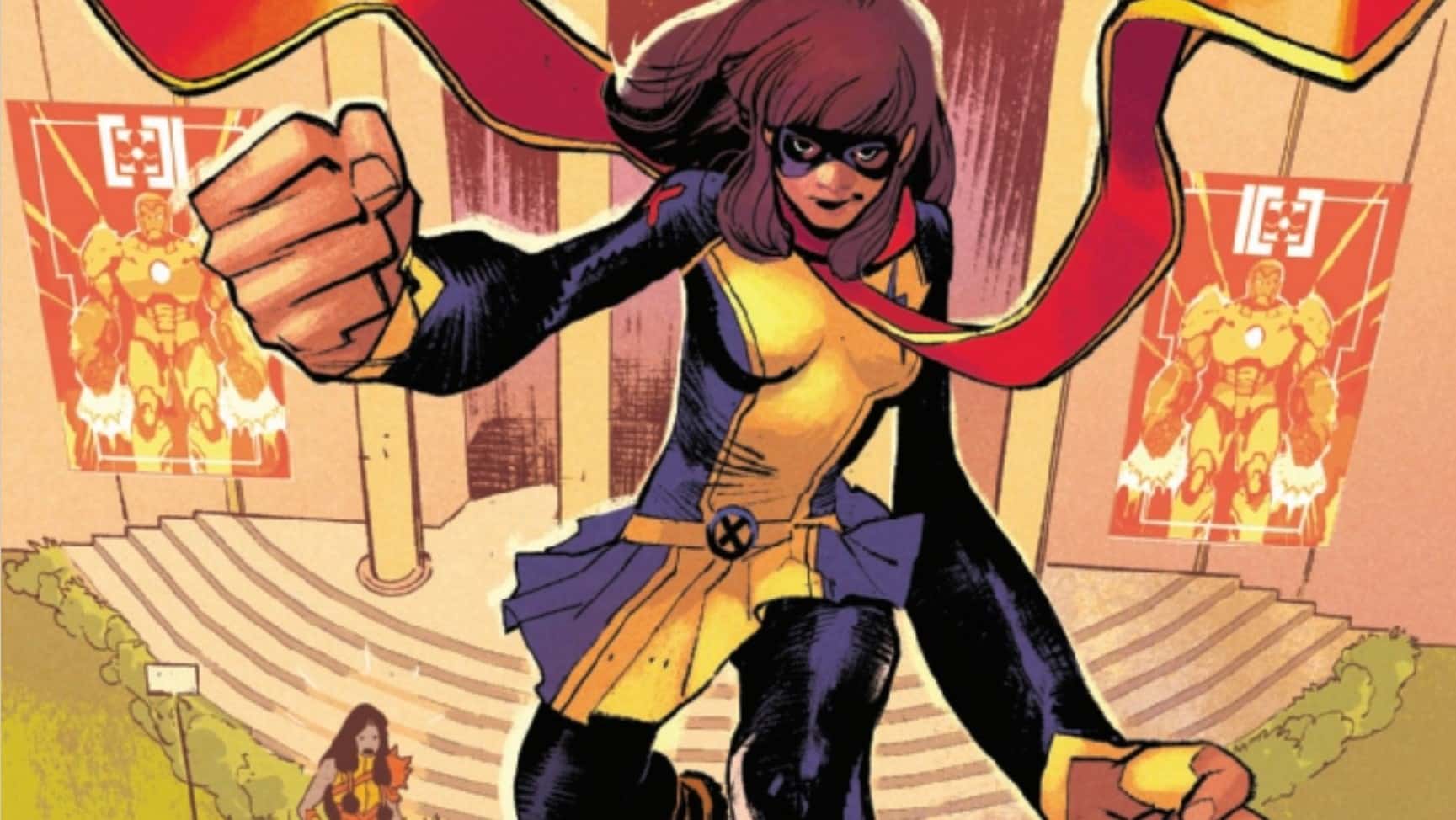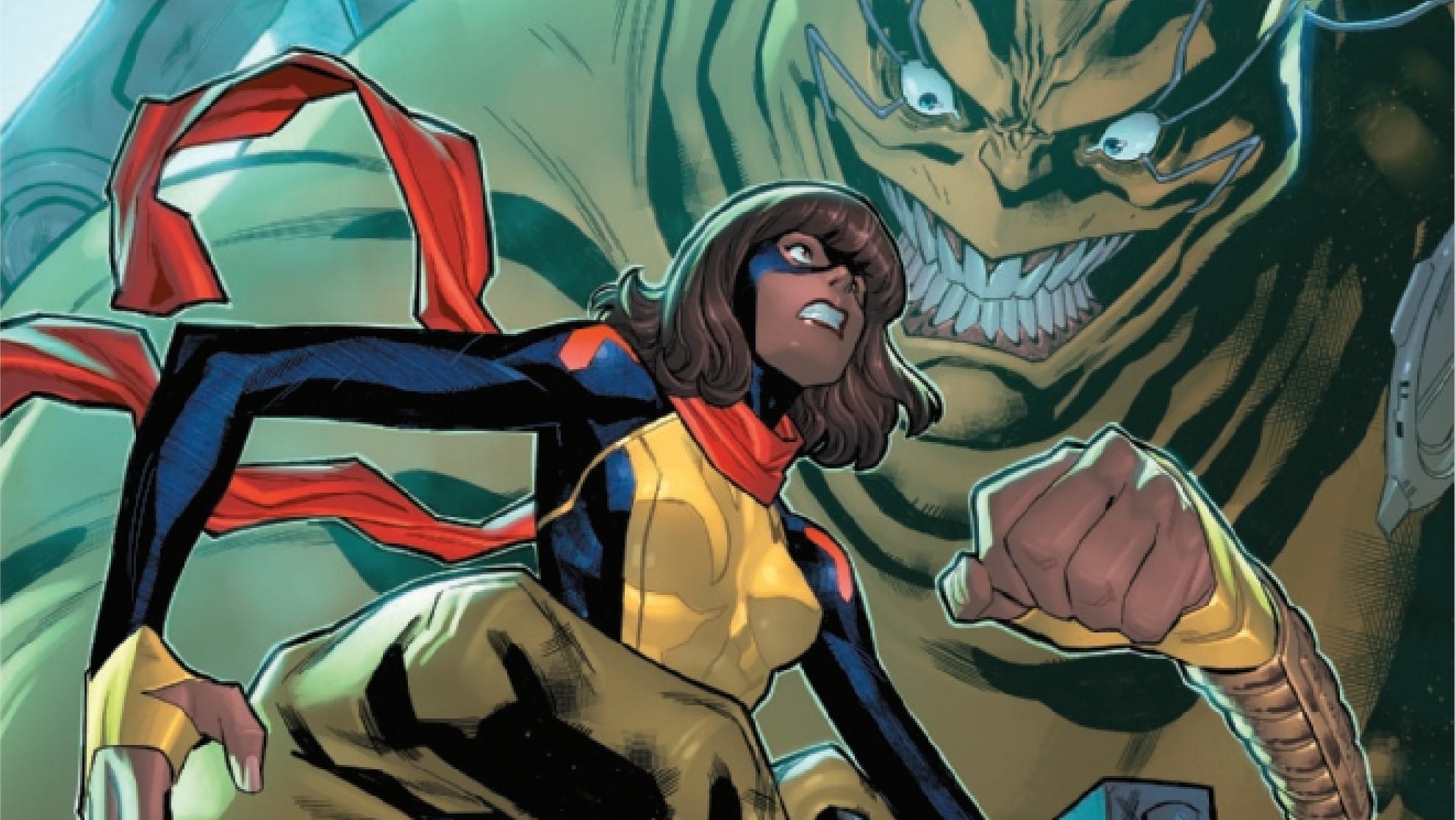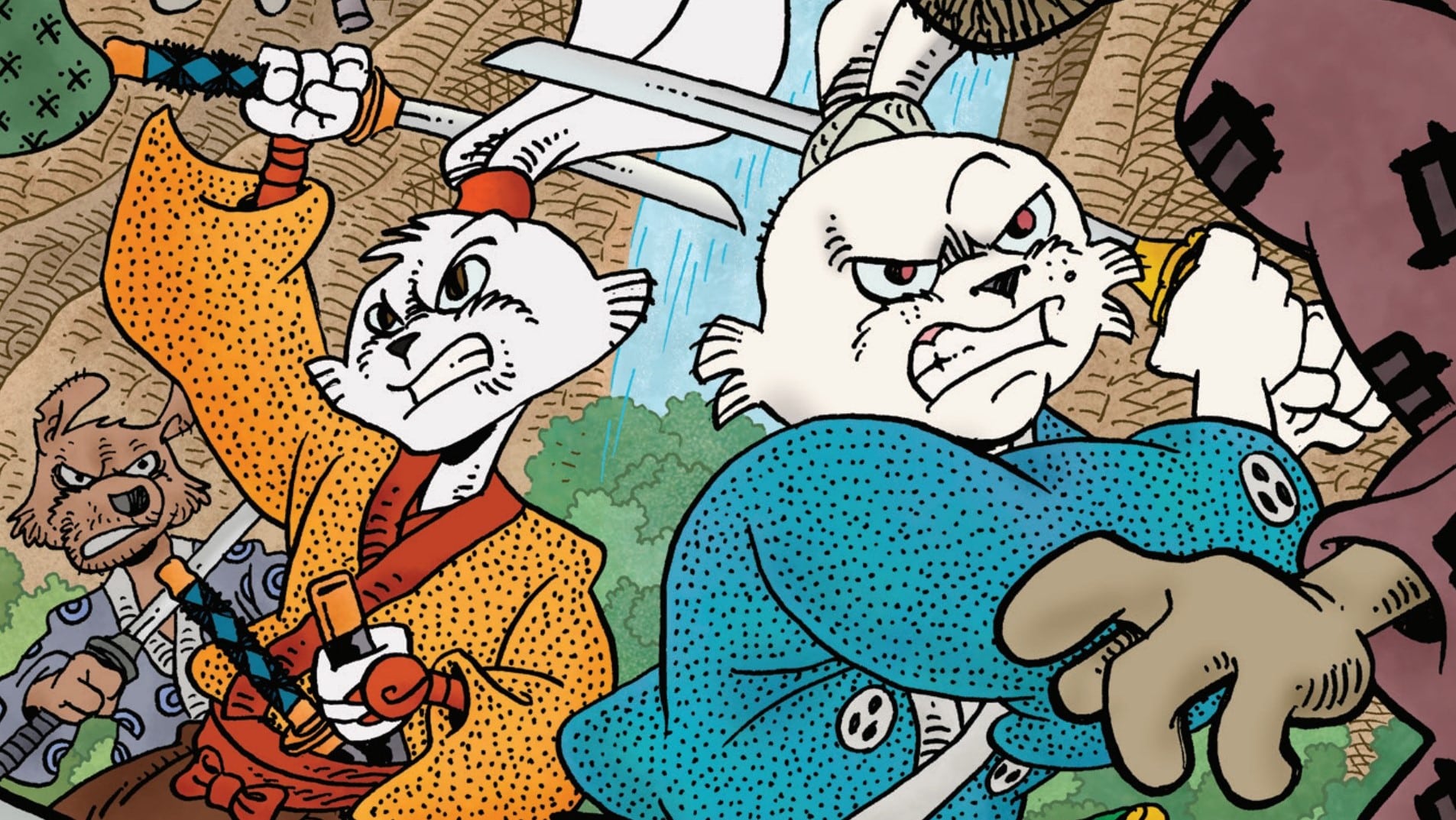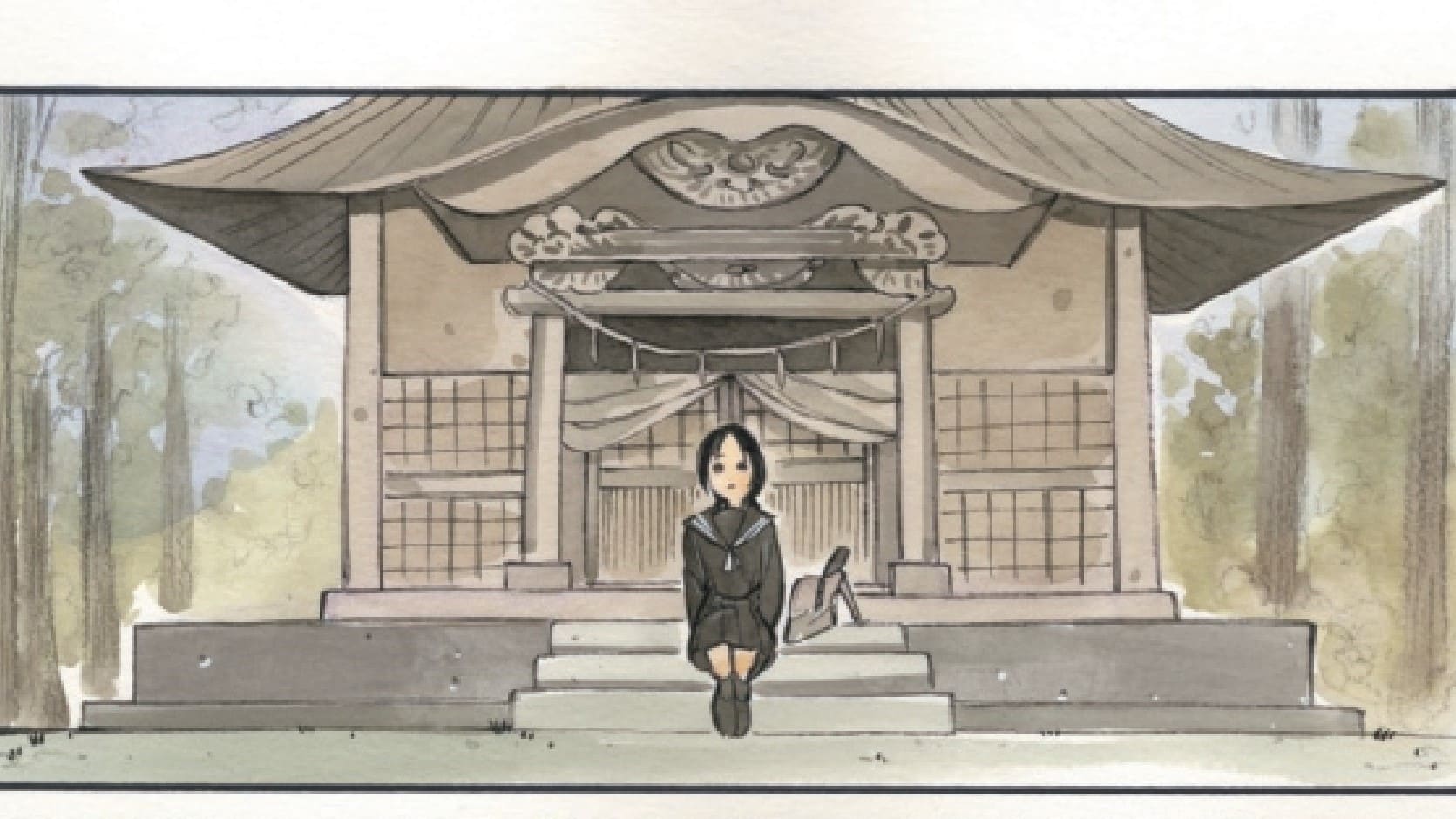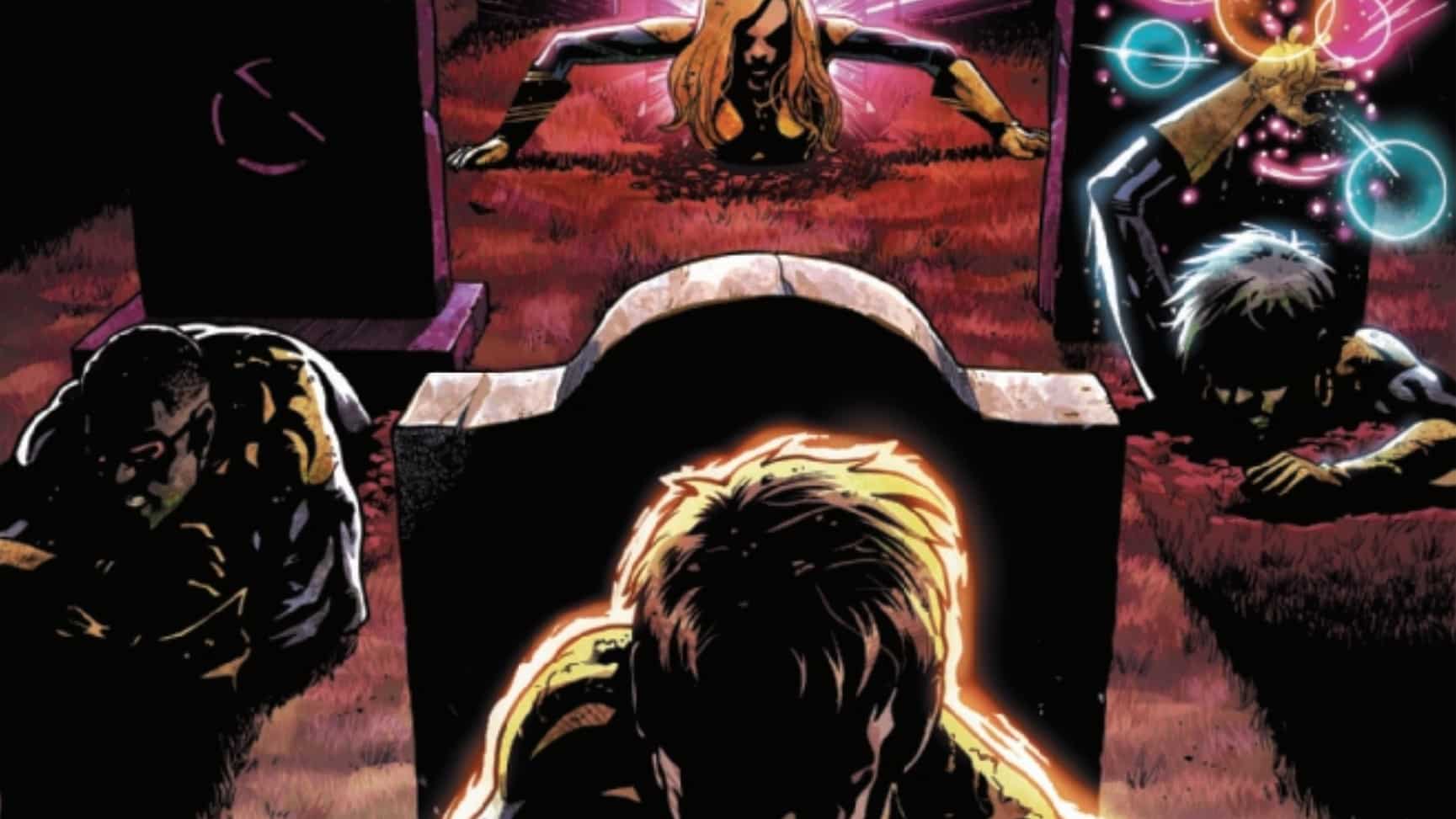Pakistani. American. Muslim. Inhuman. Mutant. Superhero. Outlaw. Avenger. Champion. Exile. X-man. There are a lot of labels on Kamala Khan, and the latest one has upended her world entirely, and given her an all-new mission statement. But underneath all the labels, when you take away the societies who believe they have a claim on her — what of her is left? Find out in Ms. Marvel #1, written by Iman Vellani and Sabir Pirzada, drawn by Carlos Gómez and Adam Gorham, colored by Erick Arciniega and lettered by Joe Caramagna, with design by Tom Muller and Jay Bowen.
Armaan Babu: I don’t think either of us were planning to cover Ms. Marvel at all, despite looking forward to the series — but when we saw how terribly her death was handled in Amazing Spider-Man #26, there was enough anger between the both of us to have to drop in and write about it. We’ve both been keeping a close eye on Kamala Khan’s subsequent resurrection, and her induction into the X-Men just in time for things to get worse for the mutants than ever. Now we’re here, and though it’s been a strange trip, I’ve got to say — I’m quite pleased with the destination. This is a great first issue!
Tony Thornley: We talked a bunch about this being all about corporate synergy when we sat down in June and chatted about it. And it is. This absolutely is a “have it in the stores in time for the movie” story. However, you’re absolutely right. This might be the best Kamala story since her original creative team left the title.
‘We’ll All Take a Piece of You’

Armaan: One of the biggest concerns I had with the direction Marvel chose to take with Ms. Marvel is that she’s got a problem of too many labels attached to her, each vying to define who she is — while losing focus on the parts of her that are the most important. It’s an approach that the show has taken, too, and it’s a direction that baffles me. When you try to make a character be everything all at once, the essence of them is always going to be drowned out.
It’s comforting to see the comic makes it very clear that the creative team is aware of that problem, in an opening dream sequence that has a lot to unpack. We have Ms. Marvel (Kamala Khan), in her traditional costume, on stage in some sort of nightmarish reality show hosted by the original Ms. Marvel (Carol Danvers, Kamala’s inspiration) in her original costume. Kamala’s surrounded by the heroes of the Marvel Universe, all of whom want her on their team, while her own disembodied hand squeezes the life out of her before she can make her choice. One of the last images she sees before the dream ends are endless rows of Ms. Marvel, all in different costumes. All the heroes she could be — all of them looking to have their piece of her.
Not the subtlest of dreams, but still open enough to interpretation to make me wonder what your take on it is, Tony. There’s a lot to unpack here — the prevalence of the original costumes of the Ms. Marvels, Kamala’s (bangled) hand being the one to battle her … it feels like who she wants to be is clashing with who she’s established herself to be. All, of course, made more complicated by the fact that she hasn’t quite figured out who she wants to be in the first place, or where she fits in best.
Tony: I feel like it’s exactly what we’ve talked about more than once being made text. I love the idea of Kamala being trapped in more than one world. She’s always been a character who puts so much on her shoulders. I feel like Champions at its best acknowledged that. As her world has grown, she’s gone beyond being a Pakistani Jersey girl, to superhero, to Inhuman, to Avenger, and so on and so on. Having that be a textual issue she’s dealing with fits her personality so well, and frankly is good to deal with.
It’s a little bit like Peter Parker’s great power and responsibility, except she’s a child of so many worlds. Her responsibility is so much more than just “use your powers for good,” and that’s a great hook. And having her fight the hand with her bangles — aka a physical representation of her core Muslim identity — makes it incredibly poignant.
Armaan: What I like about this dream is that it’s not just lampshading the concerns I have with this comic — they’re not directly dealt with in this issue, but they’re there, a fear that rises up in Kamala every time she has a moment to herself.
We have Adam Gorham on art for the dream sequence, and while the art isn’t radically different from Carlos Gómez’s style, Gorham’s is noticeably … clunkier. Cruder, garish almost, which I imagine is by design. DC’s recent Knight Terrors event has got me thinking a lot about the different things art can do to make effective dream sequences, and what works for me here is the mixture of silliness and disturbing intensity. The smiles that are a little too stiff. The way everyone else in the dream accepts its reality entirely, no matter how absurd it gets, caricatures of their real-life selves, subject to the changing whims of the dream’s rules. Like an errant thought can turn friendly faces into uncomfortable horrors — and through it all, you are not in control.
I don’t know if I’d enjoy Gorham as the sole artist for this series, but for this particular dream sequence? It worked great!
Tony: I’ve liked Gorham in everything I’ve read his work in. Positioning his more stylistic and cartoony art with Gomez’s — which is similarly cartoony but closer in line to Marvel’s house style — makes for an interesting contrast while also complementing each other. But Gorham makes the nightmare she has genuinely unsettling without being scary. It’s exactly like the nightmares you really have.
And that splash page of Kamala’s face on everyone’s body was a freakish way to end it. It’s the exact sort of moment that always wakes me up. But it doesn’t end there. It ends with an incredibly mysterious figure. … What did you think of this interesting amalgam character?
Armaan: I’m seeing a mix of the Silver Surfer and Doctor Strange, but what that means? I couldn’t tell you. I have no idea what to make of this, or where I’d even begin. I’m certainly intrigued.
A Student of Orchis

Armaan: We awake to a world drawn by Gómez, a lot closer to Marvel house style, and everyone’s looking gorgeous and stylish as hell. Everyone’s a little glammed up, but what I do enjoy about the art is that you can see the heart of the characters shining through. Gómez does great work in terms of using body language to set the scene, and to match the tone of Kamala’s inner narration.
It’s upbeat art, but the few quieter moments that pop up every now and again really hit home. I also really enjoy the background details, it really draws you in.
Tony: Gómez is very good at matching Marvel house style while adapting to the needs, themes and characters of the story. And it’s not a matter of inkers on different projects — he doesn’t work with inkers. So X-Terminators’ bright pop style has the same DNA, but here he has a softer line and some more kinetic figure work.
Every time I see Gómez on a miniseries, I’m excited, because he’s going to offer something new while still being himself.
Armaan: When I was talking about Kamala Khan’s resurrection at the Hellfire Gala to end all Hellfire Galas (literally, as far as we can tell), I’ll admit, I jumped the gun a little in terms of judgment. I felt Kamala was being taken away from her family, her community, her city, all to become a minor supporting character in X-Men stories. To be fair, until this issue, that’s more or less what’s happened. Kamala’s death was mindwiped from people as if it never happened, and her only appearances since the gala have been in her new X-Men costume — the very newest of mutants.
In this issue, though, we see her surrounded by family, seeing her off as she moves to a new college program. Her oldest and closest friend, Bruno, is going with her. She’s leaving a lot behind, yes, but as a natural progression of Kamala’s story — not the X-Men’s. She’s leaving under her own agency, and not as an agent of mutantkind. It’s a small difference, but it’s an important one.
Especially because she is still, technically, an agent of mutantkind.
Kamala’s new status quo is this: She is attending a college program at Empire State University — a program that is funded and overseen by the mutant-hating Orchis organization. In between her classes and trying to keep her civilian life in order, she’s also heading underground to meet with Earth’s few remaining X-Men, reporting on Orchis’ activities and dealing with whatever trouble is thrown her way.
Tony: I’m glad the series took a moment to include Kamala’s family. One of the biggest failures I see of most solo stories is not giving the character a supporting cast (Look at every Rogue or Nightcrawler solo ongoing series in the history of ever). I really think Ms. Marvel has succeeded in part because she has that.
Pirzada and Vellani take the time to establish her in this world before moving into Orchis U and the X-Men’s current Morlock tunnel HQ. And they bring Bruno along with her.
Armaan: I’m happy that while Kamala’s new status quo is very heavily influenced by the events of Fall of X, the X-Men themselves seem to have a reduced presence in her day-to-day life. She’s her own agent, allowed to live out her own life, instead of spending most of her time in the sewers going on missions with the X-Men. Her new status quo is being given the space to breathe here. Still, I enjoyed her visit to the sewers to meet with her fellow mutants.
There is a lot of love here for Ms. Marvel’s history. There are a ton of editor’s notes referencing the different miniseries, events and other storylines she’s been a part of — not enough to feel like an overwhelming glut of continuity, but just enough to create a sense of a real history, a character whose story is worth catching up on when you’ve got the time.
She’s also getting to hang with the nicer mutants — though I’ll admit, their inherent niceness has either been cranked up a few notches by the writing team or Kamala just happens to bring out that side of people naturally. Her interactions with the usually stoic Rasputin are especially adorable.
Tony: I love the idea of Kamala dealing with Rasputin being a fangirl. With Kamala herself being a geek, she’s able to relate and adapt to that. Rasputin is a fan of not just the X-Men but also of this era.
Also, Everett and Laura rising to be leaders among mutants continues to be my favorite Fall of X trope. I said in the gala recap, it’s one of the most believable character progressions that’s happened in the Krakoa era. Even in the desperate circumstances of this Orchis-dominated era, they’re not going grim and gritty (with Kate there in contrast). They even check on Kamala’s mental health. It’s interesting and engaging because it doesn’t go dark. But that nightmare gets brought up again. … I’m really curious where that goes.
A Mutant Coming Out

Armaan: So I may forever dislike the idea of Kamala being a mutant, but if she’s going to be a mutant, I’m glad she’s getting the space to figure it out instead. One of my favorite scenes in this issue is Kamala eating gyros with Bruno and catching him up on everything that’s been happening in her life, from her death and resurrection to learning about her X-gene. She’s very much going against the advice of Emma Frost here, but in Kamala’s own words: “I need him to know.”
The earnest, heartfelt hug he wordlessly gives her after taking a moment to process the news, and that look of comfort on her face as he does so — that’s very much my panel of the week.
Tony: Kamala and Bruno’s relationship has always been the beating heart of Ms. Marvel’s story. Their entire arc together this issue is such a highlight. He’s her rock, and it makes so much sense that she comes out to him about her mutant status. It would feel kind of wrong for her to try to leave him in the dark.
But also dang, is the mutant metaphor ever heavy with that scene.
Armaan: Things would be a lot simpler if Bruno was the only person Kamala had to come out to as a mutant. Ms. Marvel hasn’t exactly had time to announce to the world that she’s now a mutant and X-man, but when an escaped Chitauri alien from Orchis’ underground lab escapes, her new costume sends the message quite clearly.
For the record, while it looks great, I’m not a fan of what the new costume represents. Kamala Khan was her own hero, but this uniform takes away a lot of what makes her unique, making her look more or less like just another New Mutant, even with the few personal touches she’s added to the look. And as I’ve said before — I miss the bangles.
Given how this issue’s played out, however, I’m a lot more comfortable with its use. It has a role in the story. Her using it is a choice. Is it the best choice? I’m not sure, but given the situation, it seems very much in keeping with what Kamala would do.
Tony: Is Kamala going to go back to her classic costume? Yes, obviously. Probably by the end of this series at that, as part of her claiming her identity, since that theme is so obvious and prominent within the series as a whole. However, I like this costume for what it is. It’s a great merger of her classic look and the X-Men’s classic colors and design themes. The missing bangles still feel wrong, but I love that the lightning bolt is still there, and the sash is still prominent. I also really like that her skirt is a bit longer and more flowing. It’s a small touch that shows her growing up alongside everything else going on in her life.
Also, I have to compliment Gómez’s depiction of Ms. Marvel in costume. Too many artists don’t vary anything in their characters but hairstyle. He is deliberate in depicting her as herself, as in being visually consistent with Kamala Khan. He also draws her as a teenage girl, not a buxom adult woman.
Armaan: Being a mutant publicly has consequences, and now Kamala has to deal with the absurd prejudice that comes with saving lives as a mutant. Despite her best intentions, all she gets are jeers and apprehension for doing the exact same thing she’s always done as Ms. Marvel. It all hits Kamala pretty hard, and I love that this comic later makes the space for Bruno and her to spend some time together, trying to lift her spirits. That, and a reminder that Kamala’s subconscious is still trying to tell her something — but for the moment, her dreams are disturbing her too much for her to be able to hear what that message is.
Tony: This made me wonder — is her original origin as an Inhuman widely known? I mean, we know from the real world that rumors, misinformation and the like are so prominent. There are probably so many worse conspiracy theories in a world full of superhumans like the MU. I’d hate to see what conspiracy theory YouTube and TikTok looks like there.
The sequence with Kamala and Bruno playing video games until damn near sunrise is so great though. It’s relatable, both in the “we’re wild and free at college!” sense (My first night at college I stayed up until 3 a.m. chatting with a girl) and in the “trying to avoid the nightmares” sense.
Also, Michelle arriving halfway through the sequence reminded me of Ganke in Into the Spider-Verse and Judge in the Miles Morales comics. It’s a good touch because not everyone becomes friends with their roommates. She’s there, and they’re friendly, but Pirzada and Vellani don’t use the trope of “instant besties!” that too many writers would, especially writing teen girls.
Armaan: We end with a tease of some new threat coming down the line, as Omega Sentinel and a new South Asian Orchis character who might be on Ms. Marvel’s side unleash the Trojan Horse program, which does NOT sound good at all.
There’s not a lot to say about this scene for the moment, aside from this: I’m intrigued, and cannot wait to find out more about this Nitika character.
Overall, this was a really enjoyable debut. It’s been a long time since I’ve been able to unreservedly enjoy a Ms. Marvel comic. This is a limited series, but it’s working so well that I hope the creative team gets their own ongoing. This issue creates a great next step in Kamala’s story, and manages not to be derailed by some pretty major happenings. Whatever her new identity looks like going forward, this is a comic that puts Kamala Khan right in the center of her own story — and it’s about danged time.
Tony: Oh, definitely. It’s Kamala at her best, and I would love to see an ongoing series spin out of this limited series when Fall of X concludes. It’s a great start to what I hope to be something more!
Ms. Cellaneous Musings
- In case you somehow missed it, this series is co-written by Iman “I’m-not-a-Ms.Marvel-but-I-play-one-on-TV” Vellani, who by all reports has always been a huge Marvel fan even before she was cast for the Disney+ show. Check out our coverage of the show here!
- The other writer on this series is Sabir Pirzada, who if nothing else deserves a shoutout for writing the only good story involving Ms. Marvel at Oscorp, during the whole Dark Web event.
- Anyone else kind of want Kamala to adopt the sewer gator? No, just me?
- Also, sewer gators are the best trope in all of fiction.
- Kate Pryde’s evolution will be interesting to watch across all of Fall of X. She’s never been a truly bright character, which makes her one of the best. … But will she regain some happiness?
Disclaimer: As an Amazon Associate, ComicsXF may earn from qualifying purchases.

